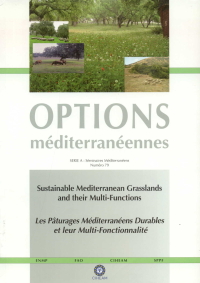| Article précédent | p. 37-40 | Article suivant |
Rehabilitation of degraded Espinales in the Mediterranean zone of Chile using annual legumes and multipurpose trees
The Espinal is a Mediterranean agroforestry system of the dryland areas of central Chile. Over the past century, the Espinal has become ecologically degraded. In this paper, results from the first four years of a long-term experiment, are presented. The objective was to study the effect of introducing mixtures of annual legumes (mixture 1 with Trifolium subterraneum, Medicago polymorpha and Trifolium michelianum and mixture 2 with Ornithopus compressus, Ornithopus sativus and Biserrula pelecinus) and woody species (Chamaecytisus proliferus subsp. palmensis and Quercus suber) on ecosystem productivity. After four years, P fertilization did not increase dry matter production (DM) of the natural pastures. The contribution of annual legumes to the pasture ranged 71-92% and 40-57%, in the first and four years, respectively. Pasture production was between two to three times greater than that of the natural pasture. The two woody species had high survival rates and high production of biomass.
L'Espinal est un système agroforestier méditerranéen des zones sèches du Chili. Au cours du siècle dernier, l'Espinal a subi une dégradation écologique. Cet article présente les résultats des quatre premières années de recherche d'un programme de longue durée. L'objectif vise à étudier les effets de l'introduction de mélanges de légumineuses annuelles (mélange 1 avec Trifolium subterraneum, Medicago polymorpha et Trifolium michelianum, et mélange 2 avec Ornithopus compressus, Ornithopus sativus et Biserrula pelecinus) et d'espèces arbustives (Chamaecytisus proliferus subsp. palmensis et Quercus suber) sur la productivité de l'écosystème. Après quatre ans, la fertilisation en P n'a pas augmenté la production de matière sèche des pâturages naturels. La contribution spécifique des légumineuses annuelles aux pâturages atteint 71-92% et 40-57%, au cours des première et quatrième années, respectivement. La production de pâturage est donc de deux à trois fois plus forte que celle des pâturages naturels. Les deux espèces d'arbres présentent des taux de survie importants, ainsi qu'une production élevée de biomasse consommable.
- [ Afficher ]
- [ Télécharger ]
- [ Exporter la citation ]
Vous pouvez télécharger la citation au format :
- [ Imprimer ]
-
Mots-clés
AMELIORATION DES PATURAGES, CHILI, DEGRADATION DE L'ENVIRONNEMENT, ECOSYSTEME, REHABILITATION FONCIERE, SYSTEME AGROSYLVOPASTORAL, ZONE MEDITERRANEENNECiter cet article
Ovalle C., Del Pozo A., Zagal E., Aronson J. Rehabilitation of degraded Espinales in the Mediterranean zone of Chile using annual legumes and multipurpose trees. In : Porqueddu C. (ed.), Tavares de Sousa M.M. (ed.). Sustainable Mediterranean grasslands and their multi-functions . Zaragoza : CIHEAM / FAO / ENMP / SPPF, 2008. p. 37-40. (Options Méditerranéennes : Série A. Séminaires Méditerranéens; n. 79). 12. Meeting of the Sub-Network on Mediterranean Forage Resources of the FAO-CIHEAM Inter-regional Cooperative Research and Development Network on Pastures and Fodder Crop, 2008/04/09-12, Elvas (Portugal). http://om.ciheam.org/om/pdf/a79/00800613.pdf



